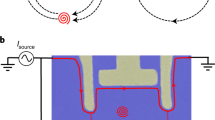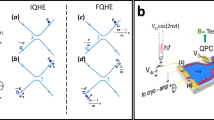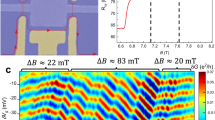Abstract
Fractional quantum Hall states have long been predicted to be a testing ground of fractional—anyonic—exchange statistics. These topological states, which can have either an Abelian or non-Abelian character, harbour quasiparticles with fractional charges. The charge of the quasiparticles can be measured by shot noise measurements, whereas their quantum statistics can be revealed by appropriate interference experiments. The multipath Fabry–Pérot electronic interferometer is easier to fabricate, but it is often plagued by Coulomb interactions, area breathing with the magnetic field and fluctuating charges. Yet, recent experiments with an adequately screened Fabry–Pérot interferometer allowed the observation of anyonic interference at a bulk filling factor of ν = 1/3. Here we demonstrate the interference and braiding of anyons in an interaction-free two-path Mach–Zehnder interferometer tuned to bulk filling of ν = 2/5 with an outermost ν = 1/3 edge mode. Interference with this mode reveals a phase dependence that corresponds to the predicted anyonic braiding. This proves that a Mach–Zehnder interferometer is a powerful tool that probes the quantum statistics of complex anyonic states.
This is a preview of subscription content, access via your institution
Access options
Access Nature and 54 other Nature Portfolio journals
Get Nature+, our best-value online-access subscription
$29.99 / 30 days
cancel any time
Subscribe to this journal
Receive 12 print issues and online access
$209.00 per year
only $17.42 per issue
Buy this article
- Purchase on Springer Link
- Instant access to full article PDF
Prices may be subject to local taxes which are calculated during checkout




Similar content being viewed by others
Data availability
Source data are provided with this paper. All other data related to this paper are available from the corresponding author upon reasonable request.
References
Halperin, B. I. Quantized Hall conductance, current-carrying edge states, and the existence of extended states in a two-dimensional disordered potential. Phys. Rev. B 25, 2185–2190 (1982).
Wen, X.-G. in Quantum Field Theory of Many-Body Systems: From the Origin of Sound to an Origin of Light and Electrons (Oxford Univ. Press, 2004).
Kane, C. L. & Fisher, M. P. A. in Perspectives in Quantum Hall Effects: Novel Quantum Liquids in Low‐Dimensional Semiconductor Structures (eds Das Sarma, S. & Pinczuk, A.) (John Wiley, 1996).
Stern, A. Anyons and the quantum Hall effect—a pedagogical review. Ann. Phys. 323, 204–249 (2008).
Zheng, H. Z., Wei, H. P., Tsui, D. C. & Weimann, G. Gate-controlled transport in narrow GaAs/AlxGa1–xAs heterostructures. Phys. Rev. B 34, 5635–5638 (1986).
Heiblum, M. & Feldman, D. E. Edge probes of topological order. Int. J. Mod. Phys. A 35, 18 (2020).
Chang, A. M. Chiral Luttinger liquids at the fractional quantum Hall edge. Rev. Mod. Phys. 75, 1449–1505 (2003).
Arovas, D., Schrieffer, J. R. & Wilczek, F. Fractional statistics and the quantum Hall effect. Phys. Rev. Lett. 53, 722–723 (1984).
dePicciotto, R. et al. Direct observation of a fractional charge. Nature 389, 162–164 (1997).
Saminadayar, L., Glattli, D. C., Jin, Y. & Etienne, B. Observation of the e/3 fractionally charged Laughlin quasiparticle. Phys. Rev. Lett. 79, 2526–2529 (1997).
Leinaas, J. M. & Myrheim, J. On the theory of identical particles. Nuovo Cim. B 37, 1–23 (1977).
Wilczek, F. Magnetic flux, angular momentum, and statistics. Phys. Rev. Lett. 48, 1144–1146 (1982).
Halperin, B. I. Statistics of quasiparticles and the hierarchy of fractional quantized Hall states. Phys. Rev. Lett. 52, 1583–1586 (1984).
Laughlin, R. B. Anomalous quantum Hall effect: an incompressible quantum fluid with fractionally charged excitations. Phys. Rev. Lett. 50, 1395–1398 (1983).
Schuster, R. et al. Phase measurement in a quantum dot via a double-slit interference experiment. Nature 385, 417–420 (1997).
Ofek, N. et al. Role of interactions in an electronic Fabry–Perot interferometer operating in the quantum Hall effect regime. Proc. Natl Acad. Sci. USA 107, 5276–5281 (2010).
Zhang, Y. M. et al. Distinct signatures for Coulomb blockade and Aharonov-Bohm interference in electronic Fabry-Perot interferometers. Phys. Rev. B 79, 241304 (2009).
Chamon, C. D. C., Freed, D. E., Kivelson, S. A., Sondhi, S. L. & Wen, X. G. Two point-contact interferometer for quantum Hall systems. Phys. Rev. B 55, 2331–2343 (1997).
McClure, D. T., Chang, W., Marcus, C. M., Pfeiffer, L. N. & West, K. W. Fabry-Perot interferometry with fractional charges. Phys. Rev. Lett. 108, 256804 (2012).
Choi, H. K. et al. Robust electron pairing in the integer quantum Hall effect regime. Nat. Commun. 6, 7435 (2015).
Nakamura, J. et al. Aharonov–Bohm interference of fractional quantum Hall edge modes. Nat. Phys. 15, 563–569 (2019).
Nakamura, J., Liang, S., Gardner, G. C. & Manfra, M. J. Direct observation of anyonic braiding statistics. Nat. Phys. 16, 931–936 (2020).
Sivan, I. et al. Observation of interaction-induced modulations of a quantum Hall liquid’s area. Nat. Commun. 7, 12184 (2016).
Rosenow, B. & Simon, S. H. Telegraph noise and the Fabry-Perot quantum Hall interferometer. Phys. Rev. B 85, 201302 (2012).
Ji, Y. et al. An electronic Mach–Zehnder interferometer. Nature 422, 415–418 (2003).
Neder, I., Heiblum, M., Levinson, Y., Mahalu, D. & Umansky, V. Unexpected behavior in a two-path electron interferometer. Phys. Rev. Lett. 96, 016804 (2006).
Neder, I. et al. Interference between two indistinguishable electrons from independent sources. Nature 448, 333–337 (2007).
Neder, I., Heiblum, M., Mahalu, D. & Umansky, V. Entanglement, dephasing, and phase recovery via cross-correlation measurements of electrons. Phys. Rev. Lett. 98, 036803 (2007).
Roulleau, P. et al. Finite bias visibility of the electronic Mach-Zehnder interferometer. Phys. Rev. B 76, 161309 (2007).
Law, K. T., Feldman, D. E. & Gefen, Y. Electronic Mach-Zehnder interferometer as a tool to probe fractional statistics. Phys. Rev. B 74, 045319 (2006).
Feldman, D. E. & Kitaev, A. Detecting non-Abelian statistics with an electronic Mach-Zehnder interferometer. Phys. Rev. Lett. 97, 186803 (2006).
Roulleau, P. et al. Noise dephasing in edge states of the integer quantum Hall regime. Phys. Rev. Lett. 101, 186803 (2008).
Roulleau, P. et al. Direct measurement of the coherence length of edge states in the integer quantum Hall regime. Phys. Rev. Lett. 100, 126802 (2008).
Halperin, B. I., Stern, A., Neder, I. & Rosenow, B. Theory of the Fabry-Pérot quantum Hall interferometer. Phys. Rev. B 83, 155440 (2011).
Rosenow, B. & Halperin, B. I. Influence of interactions on flux and back-gate period of quantum Hall interferometers. Phys. Rev. Lett. 98, 106801 (2007).
Bhattacharyya, R., Banerjee, M., Heiblum, M., Mahalu, D. & Umansky, V. Melting of interference in the fractional quantum Hall effect: appearance of neutral modes. Phys. Rev. Lett. 122, 246801 (2019).
Gurman, I., Sabo, R., Heiblum, M., Umansky, V. & Mahalu, D. Dephasing of an electronic two-path interferometer. Phys. Rev. B 93, 121412 (2016).
Goldstein, M. & Gefen, Y. Suppression of interference in quantum Hall Mach-Zehnder geometry by upstream neutral modes. Phys. Rev. Lett. 117, 276804 (2016).
Inoue, H. et al. Proliferation of neutral modes in fractional quantum Hall states. Nat. Commun. 5, 4067 (2014).
Biswas, S. et al. Shot noise does not always provide the quasiparticle charge. Nat. Phys. 18, 1476–1481 (2022).
Khanna, U., Goldstein, M. & Gefen, Y. Fractional edge reconstruction in integer quantum Hall phases. Phys. Rev. B 103, L121302 (2021).
Khanna, U., Goldstein, M. & Gefen, Y. Emergence of neutral modes in Laughlin-like fractional quantum Hall phases. Phys. Rev. Lett. 129, 146801 (2022).
Ponomarenko, V. V. & Averin, D. V. Mach-Zehnder interferometer in the fractional quantum Hall regime. Phys. Rev. Lett. 99, 066803 (2007).
Feldman, D. E., Gefen, Y., Kitaev, A., Law, K. T. & Stern, A. Shot noise in an anyonic Mach-Zehnder interferometer. Phys. Rev. B 76, 085333 (2007).
Campagnano, G. et al. Hanbury Brown-Twiss interference of anyons. Phys. Rev. Lett. 109, 106802 (2012).
Kane, C. L. Telegraph noise and fractional statistics in the quantum Hall effect. Phys. Rev. Lett. 90, 226802 (2003).
Thouless, D. & Gefen, Y. Fractional quantum Hall effect and multiple Aharonov-Bohm periods. Phys. Rev. Lett. 66, 806–809 (1991).
Guyon, R., Devillard, P., Martin, T. & Safi, I. Klein factors in multiple fractional quantum Hall edge tunneling. Phys. Rev. B 65, 153304 (2002).
Safi, I., Devillard, P. & Martin, T. Partition noise and statistics in the fractional quantum Hall effect. Phys. Rev. Lett. 86, 4628–4631 (2001).
Ofek, N. Interference Measurements at the Integer and Fractional Quantum Hall Effect. PhD thesis, Weizmann Institute of Science (2010).
Acknowledgements
We acknowledge M. Banerjee, A. Das, D. E. Feldman, Y. Gefen, I. Neder and A. Stern for useful discussions, and the continuous support of the Sub-Micron Center staff. M.H. acknowledges support from the European Research Council under the European Community’s Seventh Framework Program (FP7/2007-2013)/ERC under grant agreement no. 713351 and the Minerva foundation under grant no. 713534.
Author information
Authors and Affiliations
Contributions
H.K.K. and S.B. designed and fabricated the devices. H.K.K. and S.B. performed the measurements and analysed the data with N.O. M.H. supervised the experiment and analysis. V.U. developed and grew the heterostructure supporting the two-dimensional electron gas. All the authors contributed to writing the manuscript.
Corresponding author
Ethics declarations
Competing interests
The authors declare no competing interests.
Peer review
Peer review information
Nature Physics thanks the anonymous reviewers for their contribution to the peer review of this work.
Additional information
Publisher’s note Springer Nature remains neutral with regard to jurisdictional claims in published maps and institutional affiliations.
Supplementary information
Supplementary Information
Supplementary Sections 1–9 and Figs. 1–9.
Source data
Source Data Fig. 1
Source data for Fig. 1c.
Source Data Fig. 2
Source data for Fig. 2a,c.
Source Data Fig. 3
Source data for Fig. 3a–d.
Source Data Fig. 4
Source data for Fig. 4a–g.
Rights and permissions
Springer Nature or its licensor (e.g. a society or other partner) holds exclusive rights to this article under a publishing agreement with the author(s) or other rightsholder(s); author self-archiving of the accepted manuscript version of this article is solely governed by the terms of such publishing agreement and applicable law.
About this article
Cite this article
Kundu, H.K., Biswas, S., Ofek, N. et al. Anyonic interference and braiding phase in a Mach-Zehnder interferometer. Nat. Phys. 19, 515–521 (2023). https://doi.org/10.1038/s41567-022-01899-z
Received:
Accepted:
Published:
Issue Date:
DOI: https://doi.org/10.1038/s41567-022-01899-z
This article is cited by
-
Fractional quantum anomalous Hall effect in multilayer graphene
Nature (2024)
-
Partitioning of diluted anyons reveals their braiding statistics
Nature (2023)
-
Two-particle time-domain interferometry in the fractional quantum Hall effect regime
Nature Communications (2022)



